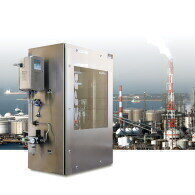Analytical Instrumentation
Corrosion Control in Desalters by On-line Monitoring of Salt Content
Mar 20 2013
Refiners can take advantage of a novel approach to corrosion management by the on-line determination of chlorides in crude oil in the desalting stage. Corrosion is the most notorious and adverse effect of improper desalting and due to the natural presence of chloride salts (calcium and magnesium salts) damaging pipe walls, heat exchanger tubes and shell, and other carbon steel components during processing. Vapours of hydrochloric acid dissolve in condensing water and form, if worse with hydrogen sulfide, an extremely corrosive environment on the top of the distillation column, naphtha exchangers, coolers or any interconnecting piping. Another drawback of excessive salts in crude is the poisoning effect on expensive catalysts used in modern operations.
Crude oil feedstock as received at refineries can have a salt content that ranges from 10 to 300 PTB or 34 to 1,020 ppm by weight, while the target salt content is usually between 0.5 to 1 PTB or 1.5 to 3 ppm by weight. In practice a crude oil desalter will reach a salt removal efficiency of 90 %, depending on the exact salt compound. Any problems associated with salt removal are always contributed by the same operational issues:
- Poor interface level measurements
- Poor quality of make-up water
- Over- or under-mixing with water
- Poor control of desalting chemicals
- Lack of chlorides monitoring
The analysis of salt (as chlorides) in crude oil is not new and defined by standard ASTM methods. Manual analysis, as described by this method, is however restrained to discrete sampling points and does not allow to identify sudden changes, nor can it be used for a proper control strategy. The UPA® Universal Process Analyzer was introduced to meet the needs of operators that wish to monitor and control precisely the salt content in the processed crude.
Chlorides are measured by conductivity and the whole analysis method is fully complying with ASTM D3230-10, which allows the analyzer’s results to be validated by laboratory staff. The analyzer mainframe is built for operation in industrial environments and rated Ex Proof conform either ATEX zone II3G or NEC500 for use in hazardous areas. A specific sampling and preconditioning system is built according to customer’s specifications, with materials and components resisting the harsh desalter environment, in order to assure high up-time and negligible maintenance.
For more information, download the technical description of the salt in crude analyzer system.
More About AppliTek
Instrumentation and process control strategies have become virtually indispensable in modern refining operations, against a background of increasing environmental regulations and specifications for fuel quality. Recently chemical operations have seen a revival of advanced on-line liquid analyzers that can be applied to determine product chemistry. Product quality assurance and reduction of chemical footprint are key objectives in this approach. With its experience obtained in the Oil & Gas sector, AppliTek has a selection of complementary analytical solutions for monitoring and controlling downstream petroleum applications. Find out more HERE>>
Digital Edition
PIN 25.2 Apr/May
April 2024
In this Edition Safety - Carbon monoxide toxic and flammable gas detection Analytical Instrumentation - Density: A fundamental parameter at critical stages within the petroleum sector...
View all digital editions
Events
May 06 2024 Riyadh, Saudi Arabia
May 06 2024 Houston, Tx, USA
May 06 2024 Houston, Tx, USA
Canada Gas & LNG Exhibition & Conference
May 07 2024 Vancouver, BC, Canada
May 08 2024 Lahore, Pakistan


















